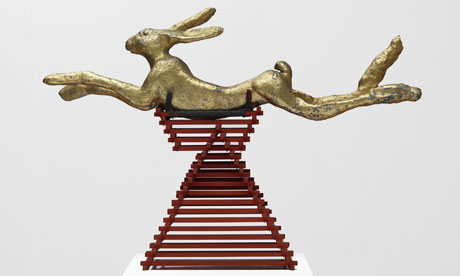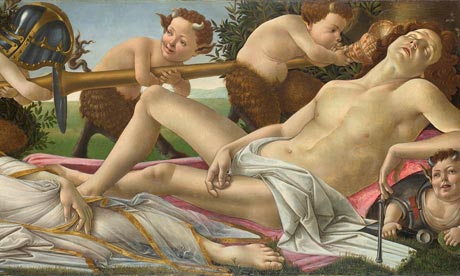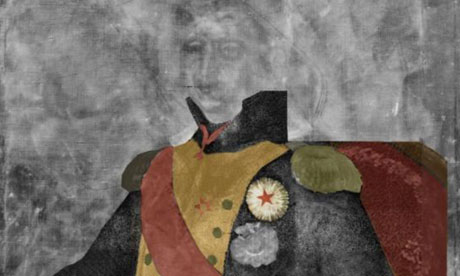THE WEEK IN ART
Lucy Skaer, Botticelli and Jeff Koons – the week in art
Sign up to the Guardian's Art Weekly email and get all the latest art world news delivered straight to your inbox

Leap into the unknown … Barry Flanagan wasn't only about hare sculptures, as Tate Britain's exhibition of his early work confirms. Photograph: Tate Modern/Tate
Jonathan Jones's top shows to see this week
Barry Flanagan
The late Welsh-born artist was best known in recent years as a sculptor in bronze, but this exhibition revisits his early work as one of Britain's boldest conceptual artists.
• At Tate Britain, London, 27 September until 2 January 2012
The late Welsh-born artist was best known in recent years as a sculptor in bronze, but this exhibition revisits his early work as one of Britain's boldest conceptual artists.
• At Tate Britain, London, 27 September until 2 January 2012
Lucy Skaer
Richly elaborated, intelligently textured, and ambitious, the art of Lucy Skaer got her shortlisted for the 2009 Turner prize. Her vision is still developing and it should be well worth seeing what she does in an abandoned cinema in Leeds.
• At Lyric Picture House, Armley, Leeds, 29 September until 15 December 2011
Richly elaborated, intelligently textured, and ambitious, the art of Lucy Skaer got her shortlisted for the 2009 Turner prize. Her vision is still developing and it should be well worth seeing what she does in an abandoned cinema in Leeds.
• At Lyric Picture House, Armley, Leeds, 29 September until 15 December 2011
Postmodernism: style and subversion 1970-1990
Was it a daring assault on cultural totems or a banal wave of 1980s commodity fetishism? And why do we think we are over it?
• At Victoria and Albert Museum, London, 24 September until 15 January 2012
Was it a daring assault on cultural totems or a banal wave of 1980s commodity fetishism? And why do we think we are over it?
• At Victoria and Albert Museum, London, 24 September until 15 January 2012
Graham Fagen
This serious and engaging artist has made a film about the experiences of people who go missing, and those who lose them, to complement Tramway's current drama The Missing.
• At Tramway, Glasgow until 2 October
This serious and engaging artist has made a film about the experiences of people who go missing, and those who lose them, to complement Tramway's current drama The Missing.
• At Tramway, Glasgow until 2 October
Pipilotti Rist
Sensational Swiss video by an artist who revolutionised feminist art in the 1990s.
• At Hayward Gallery, London, 28 September until 8 January 2012
Sensational Swiss video by an artist who revolutionised feminist art in the 1990s.
• At Hayward Gallery, London, 28 September until 8 January 2012
Up close: artworks in detail
 Different planet … Botticelli was famed for his depictions of women, but it is the male form that dominates in his vision of Venus and Mars. Photograph: The National Gallery
Different planet … Botticelli was famed for his depictions of women, but it is the male form that dominates in his vision of Venus and Mars. Photograph: The National GallerySandro Botticelli, Venus and Mars, c1485
Botticelli is famous for painting women, but did he prefer men? He was accused of sodomy before the Office of the Night in Florence, and in this scintillating vision his sensual eye dwells on the body of Mars, rather than Venus.
• At National Gallery, London
Botticelli is famous for painting women, but did he prefer men? He was accused of sodomy before the Office of the Night in Florence, and in this scintillating vision his sensual eye dwells on the body of Mars, rather than Venus.
• At National Gallery, London
Filippino Lippi, The Wounded Centaur, c1500
The art of Filippino Lippi is poetic, melancholy, often tortured by grotesque images. This painting powerfully brings to life the ancient Greek myth of a monster half-human, half-horse; here, the beast is shown suffering in the wild. It is one of the most potent Renaissance depictions of mythology in a British collection.
• At Christchurch Picture Gallery, Oxford
The art of Filippino Lippi is poetic, melancholy, often tortured by grotesque images. This painting powerfully brings to life the ancient Greek myth of a monster half-human, half-horse; here, the beast is shown suffering in the wild. It is one of the most potent Renaissance depictions of mythology in a British collection.
• At Christchurch Picture Gallery, Oxford
Francesco Guardi, View of the Palazzo Loredan, Venice, c1775-85
Recently restored to its full glory, this painting transports the beholder from modern Cardiff to Venice in the days of Casanova.
• At National Museum of Wales, Cardiff
Recently restored to its full glory, this painting transports the beholder from modern Cardiff to Venice in the days of Casanova.
• At National Museum of Wales, Cardiff
Ercole de' Roberti, Pietà, c1495
This harrowing little painting is one of the treasures that make Liverpool's Walker gallery one of the very best collections of art in Britain. Like his contemporary Michelangelo, this north Italian painter takes a gothic visual tradition and, by introducing Renaissance techniques, deepens the shock of seeing the dead Christ.
• At Walker Art Gallery, Liverpool
This harrowing little painting is one of the treasures that make Liverpool's Walker gallery one of the very best collections of art in Britain. Like his contemporary Michelangelo, this north Italian painter takes a gothic visual tradition and, by introducing Renaissance techniques, deepens the shock of seeing the dead Christ.
• At Walker Art Gallery, Liverpool
Palma il Vecchio, Venus and Cupid, c1523-4
In early 16th-century Venice, the human body was painted with unembarrassed relish and exhibited to thrill. Palma il Vecchio often portrayed courtesans and here he emulates the nudes of his rival, Titian.
• At Fitzwilliam Museum, Cambridge
In early 16th-century Venice, the human body was painted with unembarrassed relish and exhibited to thrill. Palma il Vecchio often portrayed courtesans and here he emulates the nudes of his rival, Titian.
• At Fitzwilliam Museum, Cambridge
What we learned this week
Image of the week
 Private viewing … a hidden painting, perhaps of Napoleon's brother, was found under Goya's portrait of Madrid judge Don Ramón Satué. Photograph: Rijksmuseum
Private viewing … a hidden painting, perhaps of Napoleon's brother, was found under Goya's portrait of Madrid judge Don Ramón Satué. Photograph: RijksmuseumYour art weekly
Have you seen any of these shows? What have you enjoyed this week? Give your review in the comments below or tweet us your verdict using #artweekly and we'll publish the best ones.


Lo que era un lanzamiento de la cubierta de la revista Casabella del artista se ha convertido en una metáfora marcado por la muerte del lenguaje modernista en momentos en que las compuertas estéticas abrieron en una revuelta de la subversión, la parodia, la exuberancia y kitsch.The primero que se ve en el V & A gran exposición de otoño es una imagen a partir de 1975 de una de las sillas de Alessandro Mendini 'Lassù' en llamas. Lo que era un lanzamiento de la cubierta de la revista Casabella del artista se ha convertido en una metáfora marcado por la muerte del lenguaje modernista en momentos en que las compuertas se abrieron estéticas en un disturbio de la subversión, la parodia, la exuberancia y la exposición kitsch.The traza el desarrollo del posmodernismo de sus inicios como un movimiento arquitectónico de provocación a través de su influencia en todos los ámbitos de la cultura popular. Por último, la compleja relación entre posmodernismo y la cultura de la mercancía hiper-inflado de la década de 1980 se muestra tanto a través de los diseños de los productos en sí y el arte que fue creado en respuesta.
ResponderEliminarNo se pierda
El ojo retrospectiva agudo de los curadores ha arrojado una mezcla de recompensa de la corriente principal y lo oscuro, y vale la pena el precio del billete únicamente con el video de la cantante de ópera alemán Klaus Nomi realización de rayos en un sobre el hombro acolchada, smoking brillante. los puntos culminantes incluyen los diseños subversivas de las colectividades italianas Estudio Alchymia y Memphis; gráficos de Peter Saville y Neville Brody; la elaboración de AT & T edificio de Philip Johnson (1978) presentación original; pinturas de Robert Rauschenberg y Andy Warhol; busto de Jeff Koons acero inoxidable de Luis XIV (1986); trajes de rendimiento, incluyendo gran juego de David Byrne del documental Stop Making Sense (1984); extractos de películas como Derek Jarman de The Last of England (1987); y videos que ofrecen Laurie Anderson, Grace Jones y Nueva Order.Catalogue offerSave 8 £ en el catálogo de la exposición con su Pase de Arte Nacional.
detalles del lugar
INFORMAR de las Naciones Unidas de error de Mapas
V & A (Victoria y Albert Museum)
www.artfund.org
Alessandro Mendini (1931 en Milán) es un diseñador industrial y arquitecto italiano. Jugó un papel importante en el desarrollo del estilo del diseño italiano. También trabajó por el lado de su carrera como arquitecto, para las revistas especializadas en diseño y arquitectura Casabella, Modo y Domus. En los 1970s fue una de las principales personalidades del movimiento italiano Radical design. En 1979 se unió al Estudio Alchimia como socio, donde trabajó con Ettore Sottsass y Michele De Lucchi.
ResponderEliminarComo arquitecto diseñó varios edificios, por ejemplo la residencia Alessi en Omegna Italia, el complejo de cines "Teatrino della Bicchieraia" en la ciudad de Tuscan en Arezzo, el museo del foro en Omegna Italia, la torre conmemorativa en Hiroshima en Japón, el Museo Groningen en Países Bajos y el Casino Arosa en Suiza.
Su diseño siempre estuvo caracterizado por un extraño interés en la mezcla de diferentes culturas y formas de expresión. Ha creado gráfica, mobiliario, interiores, pinturas, arquitectura y escribió varios artículos y libros. También es renombrado como un miembro entusiasta en el jurado de competencias de diseñadores jóvenes, como la competición BBEW en Corea del Sur o el Braun Prize. Además ha sido profesor de la Universidad de Milán.
Actualmente desarrolla su práctica en Milán, en el Atelier Mendini, junto con su hermano Francesco Mendini.
Enlaces externos[editar]
Sitio del Atelier Mendini (en italiano)
es.wikipedia.org
Para Francesco Guardi, se puede leer un informe muy completo en www.foroxerbar.com
ResponderEliminar24 de septiembre de 2011 - 15 de enero de 2012. Esta gran exposición fue el primer estudio en profundidad del arte, el diseño y la arquitectura de los años 1970 y 1980, el examen de uno de los fenómenos más polémicos en el arte y el diseño de la historia reciente: Postmodernismo. Se mostró cómo el postmodernismo evolucionó a partir de un movimiento arquitectónico de provocación a principios de 1970 y rápidamente pasó a influir en todos los ámbitos de la cultura popular como el arte, el cine, la música, los gráficos y la moda.
ResponderEliminarEl posmodernismo: cerca de la Exposición
De todos los movimientos en el arte y la historia del diseño, el postmodernismo es quizás el más controvertido. Esta era difícil de definir; una mezcla inestable de lo teatral y theore ...
www.vam.ac.uk
Mi comentario, expresa que una exposición de esta magnitud y con estos propósitos, motiva al público y estimula para reflexionar acerca del arte, éste no trata solamente de objetos; se trata de ideas, historia, filosofía, ética en las que podrán obtener una opinión y mayor interés en acercarse al arte. Los artistas constituyen resistencia en una sociedad, rebelión,que constituyen la base del arte.